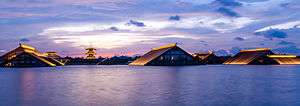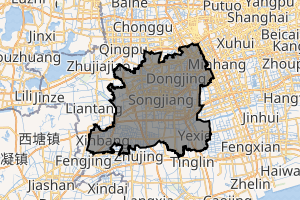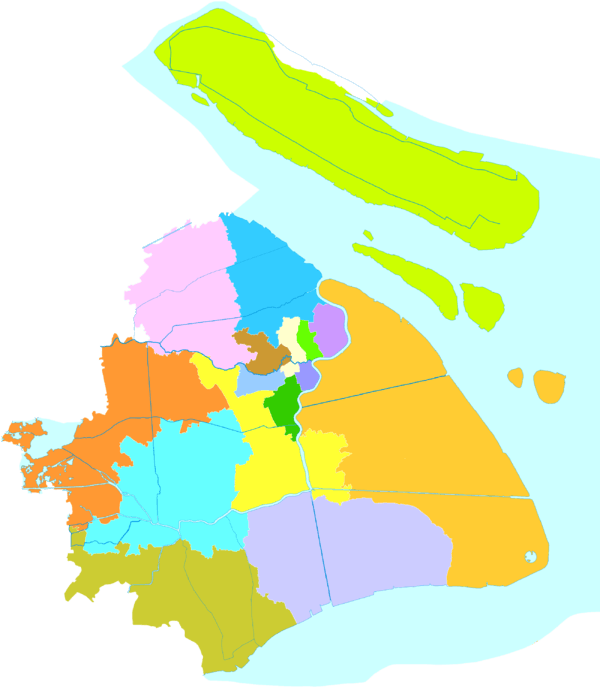Songjiang District
Songjiang is a suburban district (formerly a county) of Shanghai. It has a land area of 605.64 km2 (233.84 sq mi) and a population of 1,582,398 (2010).[1] Owing to a long history, Songjiang is known as the cultural root of Shanghai.
Songjiang 松江区 | |
|---|---|
 Songjiang Guangfulin Relics Park, containing the historical site of the Guangfulin Culture dated over 5,000 years ago. | |

| |
 Songjiang in Shanghai | |
| Country | People's Republic of China |
| Municipality | Shanghai |
| Time zone | UTC+8 (China Standard) |
| Songjiang District | |||||||||||
|---|---|---|---|---|---|---|---|---|---|---|---|
| Simplified Chinese | 松江区 | ||||||||||
| Traditional Chinese | 松江區 | ||||||||||
| Postal | Sungkiang | ||||||||||
| |||||||||||
Songjiang Town, the urban center of the district, was formerly the major city in the area. It is now connected to downtown Shanghai by Line 9 of the Shanghai Metro.
History
About 7000 years ago, people living in Songjiang created four types of unique culture: Majiabang Culture, Songze Culture, Liangzhu Culture and Guangfulin Culture, which laid a solid foundation of multicultural characteristics of Shanghai Culture. Songjiang was formerly known as Huating County (华亭县) and was part of Jiangsu province.
In AD 751, during the mid-Tang Dynasty, Huating County was established at modern-day Songjiang, the first county-level administration within modern-day Shanghai.
In the Yuan Dynasty, Huating County was raised to prefecture status and changed its name to Songjiang Prefecture (松江府).
Under the Republic of China, the Songjiang Special Administration District extended as far as Chongming Island in northern Shanghai.[2]
In 1998, the current Songjiang District was established.
Cultural Significant Features
As the cultural root of Shanghai, Songjiang preserves brilliant and unique prehistoric, ancient and modern cultural significant features.
In the prehistoric period, there formed Majiabang Culture, Songze Culture, Liangzhu Culture and Guangfulin Culture in Songjiang. The recent unearthed farming and working tools as well as rice and animal remains proved that people living in Songjiang at that time had already known how to plough the farming land, which pushed the primitive agricultural society forward to a more civilized one.
At the beginning of the 21st century, discoveries in Songjiang Guangfulin Cultural Relics made great contribution to archaeology. Firstly, it clearly divided the primitive society into types like Songze Cultural, Liangzhu Cultural and Guangfulin Cultural, which was considered to be the cultural relics of New Stone Era in Taihu area; secondly, immigrants from the Yellow River were conformed to be the first group of immigrants coming Shanghai; thirdly, there were towns in Shanghai dating back to as far as Zhou Dynasty; fourthly, two unique types of houses in primitive society were found: stilt house and ground house.
As time passed by, there were two important periods in the ancient Chinese society: the Western Jin Dynasty and the Ming Dynasty, characterized by the following four significant cultural features:
1.Originality
Excellent cultural environment in Songjiang cultivated a great number of elites, represented by litterateurs like Lu Ji and Lu Yun in the Western Jin Dynasty, Chinese painters like Dong Qichang in the Ming Dynasty and writers like Tao Zongyi in the Yuan Dynasty. They all created revolutionary and practical theories into their fields, making great contribution to the further development of Chinese art and literature, and were known to us for their originality and creativity.
2. Inclusivity
There were many kinds of art and literature schools in Songjiang, and three historical immigrants from the northern part of China, respectively taking place at the end of Jin Dynasty, mid-Tang Dynasty and Song Dynasty, brought along northern culture and stimulated the cultural kindness and inclusivity of Songjiang. In addition, when the five biggest religions in China are growing bigger and bigger and get along with each other in Songjiang, they learned from not only other religions but also unique culture in Songjiang and formed their special characteristics, which shows the cultural inclusivity in Songjiang culture.
3. Guidingness
A famous art and literature school---Yunjian rooted and gained its fame here. Yunjian school represents both ancient literature and modern ones, combining practical ideas with ideal ones, which has a profound influence on the development of ancient Chinese poetry, painting and calligraphy. Its representatives are Chen Zilong, Chen Wen, Mo Shilong, Dong Qichang and Lu Ji.
4.radiativity
From the beginning of ancient Chinese imperial examinations at the end of the Sui Dynasty, Songjiang had cultivated all together 521 Jinshi, successful candidates in the highest imperial examinations, which was a rare scene in the Chinese examination history. These successful candidates, being high government officials, all made great contributions to the country. Songjiang also has great influence on the development of newspaper, cotton manufacturing and agriculture.
Significant Features
Some of the notable features in Songjiang District include:
- Songjiang New City is a major new-town development located within Songjiang District. It was developed as part of Shanghai's "One City, Nine Towns" plan. The New City will encompass an area of 60 square kilometers (23 sq mi) when completed, and will have a total population of 500,000 residents.[3] The New City reflects Garden City design principles, with a large proportion of land allocated to green-space and parks.
- Thames Town is a residential and commercial development located within the Songjiang New City that both imitates and is influenced by classic English market town styles. Some of the architecture has been directly copied from buildings found in England.
- Songjiang University Town is a major higher education sector located in the district. It is the largest higher education sector in mainland China.
- Shanghai First People's Hospital has a campus located within the Songjiang New City.
- Shanghai Film Studios are located in Songjiang District.
- InterContinental Hotel Shanghai Wonderland is built against the walls of a former quarry, and partly underwater: it claims to be the world's first underground five-star resort.[4]
Cultural sights in Songjiang include:
- Sheshan Hill with Sheshan Basilica
- Fangta Park, one of the first celebrations of traditional Chinese architecture following the Cultural Revolution, including the city's Square Pagoda and Mazu Temple
- Huzhu Pagoda on Tianmashan
Government and infrastructure
The Shanghai Women's Prison is in Songjiang District.[5]
Transport
Songjiang District is located approximately 25 kilometers (16 mi) from Hongqiao International Airport and 70 kilometers (43 mi) from Pudong International Airport. Songjiang is currently served by one metro line operated by Shanghai Metro, one suburban line operated by China Railway, and two tram lines.
Metro
- Line 9 - Songjiang South Railway Station, Zuibaichi, Songjiang Sports Center, Songjiang Xincheng, Songjiang University Town, Dongjing, Sheshan, Sijing, Jiuting
Suburban Rail
- Jinshan railway - Chunshen, Xinqiao, Chedun, Yexie
Subdistricts and towns
Songjiang District has six subdistricts, eleven towns and three special township-level divisions.
| Name[6] | Chinese (S) | Hanyu Pinyin | Shanghainese Romanization | Population (2010)[7] | Area (km2) |
|---|---|---|---|---|---|
| Yueyang Subdistrict | 岳阳街道 | Yuèyáng Jiēdào | ngoq yan ka do | 112,671 | 5.65 |
| Yongfeng Subdistrict | 永丰街道 | Yǒngfēng Jiēdào | ion fon ka do | 93,330 | 24.53 |
| Zhongshan Subdistrict | 中山街道 | Zhōngshān Jiēdào | tzon se ka do | 98,888 | 26.34 |
| Fangsong Subdistrict | 方松街道 | Fāngsōng Jiēdào | faon son ka do | 414,548 | 14.76 |
| Guangfulin Subdistrict | 广富林街道 | Guǎngfùlín Jiēdào | kuaon fu lin ka do | 19.05 | |
| Jiuliting Subdistrict | 九里亭街道 | Jiǔlǐtíng Jiēdào | cioe lij din ka do | 6.79 | |
| Chedun town | 车墩镇 | Chēdūn Zhèn | tsau ten tzen | 167,687 | 45.30 |
| Dongjing town | 洞泾镇 | Dòngjīng Zhèn | don cin tzen | 57,861 | 24.51 |
| Jiuting town | 九亭镇 | Jiǔtíng Zhèn | cioe din tzen | 147,398 | 26.13 |
| Maogang town | 泖港镇 | Mǎogǎng Zhèn | mo kaon tzen | 41,626 | 57.62 |
| Sheshan town | 佘山镇 | Shéshān Zhèn | sau se tzen | 32,295 | 55.70 |
| Shihudang town | 石湖荡镇 | Shíhúdàng Zhèn | zaq wu daon tzen | 44,011 | 44.28 |
| Sijing town | 泗泾镇 | Sìjīng Zhèn | sy cin tzen | 94,279 | 23.98 |
| Xiaokunshan town | 小昆山镇 | Xiǎokūnshān Zhèn | sio khuen se tzen | 51,606 | 30.52 |
| Xinbang town | 新浜镇 | Xīnbāng Zhèn | sin pan tzen | 33,627 | 44.75 |
| Xinqiao town | 新桥镇 | Xīnqiáo Zhèn | sin djio tzen | 155,856 | 31.43 |
| Yexie town | 叶榭镇 | Yèxiè Zhèn | yiq zia tzen | 80,104 | 72.49 |
| Sheshan Resort | 佘山度假区 | Shéshān Dùjiàqū | sau se du ka chiu | 42,583 | 64.08 |
| Shanghai Songjiang Export Processing Zone | 上海松江出口加工区 | Shànghǎi Sōngjiāng Chūkǒu Jiāgōngqū | zaon he son kaon tseq khoe ka kon chiu | 60,797 | 2.98 |
| Songjiang Industrial Zone | 松江工业区 | Sōngjiāng Gōngyèqū | son kaon kon gniq chiu | 43.69 |
Attractions
Xilin Chan Temple is a Buddhist temple in Yueyang Subdistrict, which is also a famous tourist attraction.
Zuibaichi is one of the five ancient Chinese gardens in Shanghai that dates back to the Song Dynasty.
The Songjiang Mosque is the oldest mosque in Shanghai with its latest rebuild in 1391.
Songjiang's emblematic tower is the 9-story Fangta Pagoda, or Songjiang Square Pagoda.
Notable people
Birthplace:
- Han Bangqing - Author of The Sing-song Girls of Shanghai (Lou County, Songjiang Prefecture)[8]
Heroes: Hou Shaoqiu, Jiang Huilin, Xia Yunyi, Chen Zilong, Xia Wanchun;
Statesmen: Gu Yong, Lu Xun, Xu Jie;
Litterateurs: Lu Ji, Lu Yun, Chen Jiru, Qian Fu, Gu Qing;
Chinese Painting and Calligraphy (Songjiang was listed among "cities of Calligraphy" in 2013[9]) Artists: Shen Du, Dong Qichang, Zhang Nanheng, Zhang Zhao, Shi Zhecun, Cheng Shifa;
Craftsmen: Zhu Kerou, Huang Daopo, Ding Niangzi;
Experts: Tao Zongyi, Zhu Shunshui, Chen Yongkang;
Educators: He Dong, Ping Hailan, Ma Xiangru.
Intelligent woman: Ye Gu
References
- Shanghai 2010 Census Data Archived 2014-04-03 at the Wayback Machine Shanghai Statistics Bureau
- "Chongming County" in the Encyclopedia of Shanghai, pp. 50 ff. Archived 2013-03-02 at the Wayback Machine Shanghai Scientific & Technical Publishers (Shanghai), 2010. Hosted by the Municipality of Shanghai.
- Shanghai Agriculture - The construction of Shanghai's experimental city, Songjiang "Archived copy". Archived from the original on 2012-03-28. Retrieved 2011-08-06.CS1 maint: archived copy as title (link)
- "50 of the world's most unusual hotels". Telegraph.
- Zhao, Wen. "Women behind bars meet their mothers" (Archive). Shanghai Daily. Saturday March 8, 2014. Retrieved on December 21, 2015.
- 2010年松江区行政区划_松江区_行政区划网 www.xzqh.org (in Chinese). XZQH. Archived from the original on 2012-11-15. Retrieved 2012-05-24.
- Census Office of the State Council of the People's Republic of China; Population and Employment Statistics Division of the National Bureau of Statistics of the People's Republic of China (2012). 中国2010人口普查分乡、镇、街道资料 (1 ed.). Beijing: China Statistics Print. ISBN 978-7-5037-6660-2.
- Wang, David Der-wei. "Foreword." In: Han Bangqing (2005). The Sing-song Girls of Shanghai. Columbia University Press. ISBN 9780231122689. Google Books PT9.
- "Culture old and new in focus". mobile.shanghaidaily.com. Retrieved 2017-05-16.
Further reading
- "Songjiang District". Encyclopedia of Shanghai. Shanghai Municipal Government. 2010. Archived from the original on 2013-03-02.
External links
| Wikimedia Commons has media related to Songjiang District. |
| Wikivoyage has a travel guide for Songjiang District. |

